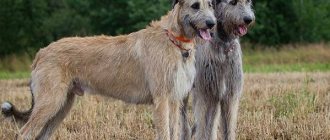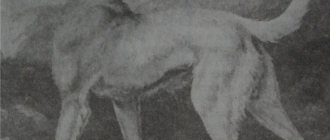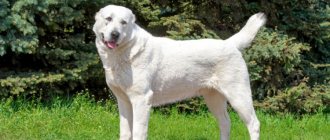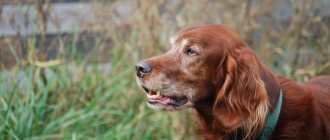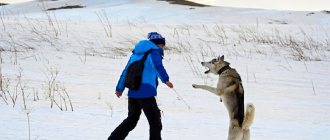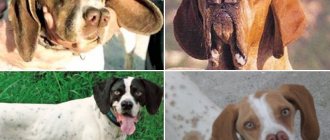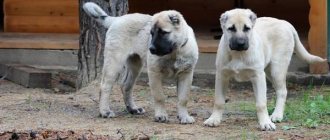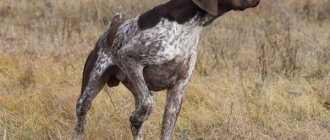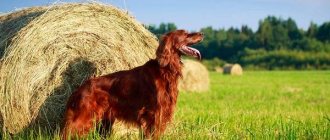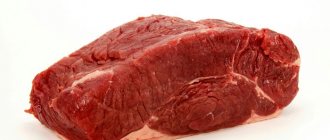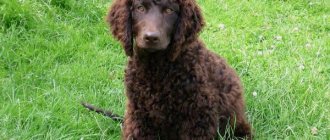Description of the Irish Wolfhound breed
Popularity 212th place among 263 dog breeds
Lifespan:
6-11 years
Breed group:
Greyhounds
Height:
males: 79-85 cm, females: 71-80 cm
Country of origin:
Ireland
Average price:
60-80 thousand rubles
Weight:
males: 54.5-58 kg, females: 40.5-46 kg
Latest articles Cat health
Ataxia in cats: what it is, how it manifests itself and is treated 01/23/2022 173 0 0
Cat health
Leukemia, or viral leukemia in cats 01/23/2022 152 0 0
Tobet
Tobet is a Kazakh wolfhound. A majestic mountain breed of hardy and unpretentious dogs, next to whom it is calm and warm.
These are faithful friends in everyday life and on the hunt, ideal for the nomadic lifestyle of the indigenous population.
Tobet serves man, climbing to high places and protecting the owner and this property from predators.
Key facts
The Irish Wolfhound, despite its impressive size, is a relatively good-natured and peace-loving dog. This makes the giant suitable for the role of a companion dog. It is almost impossible to turn him into an aggressive fighter. He also turns out to be a very mediocre security guard.
The colorful dog has long been the mascot of the Royal Irish Regiment. The animal also has the status of a national breed. Representatives are even in service at the court of the Queen of Great Britain.
Only animals that have reached two years of age can be called adults. This is due to their slow growth.
Representatives of this breed are very smart, but do not like drills, so they remember commands well, but carry them out reluctantly.
Pets have a huge, but not limitless, reserve of patience, so giants calmly treat children and other animals. Only aggression towards a beloved owner or an awakened hunting instinct can provoke a dog to display aggression.
Nagazi
Nagazi is a Georgian wolfhound. An intelligent and daring guard dog of Georgian sheep breeders, it helps protect sheep from predators - wolves, leopards, bears, etc.
Nagazi is cruel to predators, has endurance and power. She will listen and carry out the commands of one owner, protect his house and property. The Georgian wolfhound has thick hair and is not afraid of the harsh mountain climate.
History of the origin of the Irish Wolfhound breed
This is an ancient breed of dog. Their history is unclear, but the individual was created by breeding large British dogs and Middle Eastern hounds. When the Romans conquered the British Isles, these giants already existed. In 391 AD, seven pets were presented to the Roman consul. From that time on, their popularity among wealthy landowners and other nobility only grew.
The purpose of breeding was to hunt big game and other predators, including the now extinct Irish elk. Dogs became especially popular in the 15th century. It was then that the wolf population got out of control and created a threat to all living things. Dogs performed their hunting duties so well that wolves almost became extinct in the 18th century.
Unfortunately, this also put the Irish people out of work, so the breed almost disappeared. A British army captain named George Augustus Graham considered it his mission to save the giants and increase their numbers. In the 19th century, the military began to look for the best representatives of the breed for the purpose of breeding them. Over time, Graham restored the giants' numbers, setting a breed standard.
The most famous Irish wolfhound was named Gelert. It belonged to the Prince of North Wales. There is a legend that characterizes the attitude towards dogs.
According to her, the prince briefly left his child with the dog. Upon returning, the crowned lady discovered that the baby was missing and the dog was covered in blood. The prince killed the animal, but when he breathed his last, he heard the cries of his child. It turns out that the dog was covered in wolf blood. The dog killed the beast to protect his little master. The prince was in despair and is said to have never smiled again.
On the territory of the Soviet Union, people learned about the Irish giant in the late 1980s. At that time, several purebred dogs were imported from Poland. A few years later, they were joined by manufacturers from Germany, Hungary and other European countries.
Typical behavior of a Caucasian
We already know that, in general, the wolfhound is a guard breed, therefore, all its representatives must have a tough character. It is this quality that concerns the Caucasian, who has been hunting the most violent predators since ancient times. The very first wolfhounds lived in the wild. They fed on both small forest inhabitants and predators. When people began to domesticate them, the breed became famous throughout the world. They went hunting with wolfhounds of this color in all corners of the world, since only they were able to kill animals such as lynx, wild boar or deer. Today they are used as the best watchmen and security guards. Due to the fact that the animal’s character is very ferocious, it recognizes only its owners. The owners claim that the dog is not very playful, but requires constant physical activity in order to keep its muscles in good shape.
Appearance of the Irish Wolfhound
General impression
The Irish Wolfhound is usually described as a very muscular and strong dog. He has a graceful build but is very active due to his enormous size. The neck is carried proudly while the tail is carried up.
Head
The head of the Irish giant has an elongated shape. The pet's forehead is flat and somewhat narrowed. The muzzle is elongated.
Nose, eyes and ears
Small eyes should be as dark as possible. The ears of a wolfhound are small. They have a pink shape. The nose is dark and large.
Teeth and bite
The Irishman has a scissor or level bite. However, by Irish Wolfhound standards, the first option is preferred.
Neck
A purebred giant has a long neck covered with strong muscles. Its shape is slightly elongated. The skin on the neck is tightly stretched.
Torso
The dog's body is elongated. Toward the croup, the body widens quite noticeably. The dog's lumbar part is convex. The chest is strongly developed and quite deep. The abdominal part is lean.
Forelegs
The paws of the Irish Wolfhound are bony. The forelimbs are long. placed straight.
Hind limbs
The animal's long and very muscular legs have low hocks. The paws have a rounded shape. The thighs are muscular.
Tail
The tail of the giant specimen is thick and long. It has a slight bend that is barely noticeable.
Movements
Despite its large size, the dog does not look clumsy or heavy. The dog's movements are striking in their ease and flexibility.
Wool
The giant's coat consists of coarse hair. Especially on the muzzle and brow ridges. The hair there actually looks like wire.
Color
The colors of the Irish Wolfhound are varied. In nature, there are brindle, gray, fawn, red, white and black giant dogs.
Size
Looking at the photo of the Irish Wolfhound, you are amazed at its size. Females grow on average to 71 cm, males should not be lower than 79 cm. The weight of the dogs is also impressive. Thus, the body weight of females starts from 40.5 kg, in males – from 54.5 kg.
Disqualifying faults
Finding a purebred pet that fully meets the breed standards is quite difficult. If an animal is purchased to participate in competitions, then the choice of a puppy must be taken especially carefully.
Here are the possible defects:
- too large or small skull;
- convex frontal part;
- square short body;
- twisted limbs;
- back without natural arch;
- big ears;
- the neck is short, with dewlap;
- Abnormalities of the chest - too wide or narrow;
- strong bend or thin tail.
If the pet has a light lobe, this will also be a serious disqualifying fault. The animal's lips and eyelids should not be any shade other than black. The same goes for the eyes. The iris should only be as black as possible.
Alabai. External data
One of the most popular colors among all wolfhounds. Alabais are not an artificially bred breed, since they are native to the Central Asian regions of Russia and adjacent countries. Since ancient times, such dogs were used to protect pastures and homes; later they became bodyguards of their owners, their faithful companions during hunting or long hikes. In terms of their parameters, Alabai can be equal to Irish wolfhounds. The height at the withers reaches 80 centimeters, and the weight is 80 kilograms. They have a very large and short muzzle with a huge nose, black or dark brown in color. The ears are drooping and small, most often they are cropped. The torso of the Alabai is both long and full. The chest is wide, the ribs are rounded, and there is a slight high rear.
Personality of the Irish Wolfhound
Attitude towards children and animals
Irish Wolfhounds are caring companions who love their family. They love everyone equally. The dog is even affectionate with other dogs, and sometimes with the domestic cat. The Irishman loves to lie on the sofa and climb onto the bed under the blanket with his beloved owner.
He does not tolerate being left home alone for too long. To keep your four-legged friend calm, he needs a family that can keep him company most of the day.
We must remember that this breed was bred for hunting. Therefore, a dog that can kill a wolf will easily knock down a person if it decides to chase the neighbor's cats.
Large pets are affectionate with children, but due to their large size, they can accidentally knock kids down, scare or injure them. Large animals are best for families with older children. However, giants are not ponies, and children should not ride them. The dog may get hurt if a child tries to ride it.
With early socialization and training, your pet can get along well with other dogs. He will begin to chase small animals such as cats unless he has been raised with them and taught not to do so.
It is vitally important to properly introduce him to other pets and monitor their interactions. Otherwise, your four-legged friend will consider street cats and other small animals prey.
Who is suitable and not suitable
This giant breed is not the best choice for small homes or apartments. The dog will do much better in a large country cottage where he has room to wag his tail without the threat of knocking things over.
It is suitable for families of all shapes and sizes, including older children. This breed tends to be calm in the home and does not make noise, making him an excellent "sibling dog" for children of all ages. They simply cannot be ignored.
Reviews
By nature, the Irishman is a loving, gentle, intelligent dog. But you need to be extremely careful not to accidentally offend the dog during training. Although it seems that the pet does not need commands, as if he already knows how to do everything.
The Irishman is unpretentious, living in an apartment, he behaves calmly. Feeding a wolfhound is expensive, due to the size of the dog. It is best to live with a pet outside the city: there he can walk peacefully without scaring anyone.
The wolfhound looks menacing in appearance, but is a very kind dog. Gets along well in a large family with children. Loyal, finds a common language even with cats.
Education and training
How to fight the hunting instinct
Due to its size, the Irish Wolfhound requires less activity than other breeds. They only need 30-40 minutes of intense exercise every day. The dog is best suited for leisurely walks, short runs in the forest and quick jumps on the beach. If you are looking for a partner to jog for long periods of time, this is not your dog.
“ His high prey drive means that his owner will need to keep him on a leash at all times. Because if the dog sees something fast and fluffy, he will run - and you definitely won’t stop him.
If you live near an enclosed dog park or fenced field, you may want to let him off leash. Short periods of vigorous running are a great way to keep his heart healthy and his mind happy.
This is an intelligent dog that likes to be varied in its activities. Walking down the same street every day will sooner or later get boring. Your dog will enjoy chasing or tracking, so it can be helpful to find local dog clubs for him to join in on the fun.
“ Read more about coursing for dogs
Hunter skills training
A smart puppy is easy to train. As an animal bred to serve alongside humans, it is a breed that strives to please its owner. Of course, you need to start training early to teach your baby to be obedient.
With the right guidance, your pet will become a competent adult. Positive reinforcement training is the best way to train this giant breed.
The only thing that is difficult to “remove” from a wolfhound is its desire for prey. The ancestors of the Irish Wolfhound were intended for hunting. This is an innate instinct, so it will not be difficult to make him an excellent hunter of living creatures. A trip to the forest with your owner and encouragement when catching a wild animal is the best way to awaken the hunter in him.
Maremmo-Abruzzese Shepherd Dog
A snow-white Italian with a proud character and large dimensions forces you to take your opinion into account. The first information about it appeared in the first century AD; the name comes from two Italian regions of Maremma and Abruzzo.
The herding dog was used to protect livestock from predators on the farm, and can even cope with a bear. The Maremmo-Abruzzese Shepherd is an active, strong and intelligent dog.
Irish Wolfhound Health and Diseases
Possible diseases
Large pets have a short lifespan, ranging from 6 to 11 years, but they can live happily if they are well cared for.
The easiest ways to keep your pet active and healthy are to have regular checkups with your veterinarian, provide a balanced diet, and exercise regularly.
Like all purebred dogs, this breed is susceptible to certain diseases. Below we have listed the most common health problems to look out for:
- Dysplasia
of the hip and elbow joints.
This is a common problem for large dogs. Puppies grow quickly, which can cause their bones to develop unevenly. This pathology leads to faster wear and tear of the joints, which ultimately causes pain and arthritis. It is important to breed individuals with good hip scores to reduce the chances of their puppies inheriting the condition. Symptoms of the disease include stiff limbs, exercise intolerance and inability to stand up quickly. - Eye diseases.
The giant is prone to various vision problems. The most common are cataracts, corneal dystrophy, distichiasis, iris cysts, progressive retinal atrophy or dysplasia. The reason for contacting a veterinarian may be any changes in the eyes: excessive tears, dryness, redness, inflammation or constant itching. If the disease is not treated, it can lead to complete blindness.
- Heart diseases.
About a third of the breed develops dilated cardiomyopathy (DCM). This disease is characterized by an enlarged and weakened heart chamber that cannot pump blood properly. The problem can be detected by heart murmurs. Unfortunately, the disease leads to heart failure.
- Pneumonia.
This disease is often diagnosed in representatives of the breed. Pneumonia is usually caused by other medical problems, such as a cough, surgery, or infection. Lethargy and loss of appetite are usually the first symptoms associated with pneumonia. If you suspect pneumonia, you should immediately take your four-legged friend to the veterinarian for treatment, as this is life-threatening.
- Portosystemic (hepatic) shunt.
The disease develops when abnormalities occur in the liver, causing it to be unable to filter toxins from the blood. This is a life-threatening condition and is usually determined only by testing. Symptoms include behavioral changes, vomiting, diarrhea, increased urination and weight loss.
- Cancer.
This breed is susceptible to several types of cancer. The most common is osteosarcoma (a type of bone cancer). Symptoms include lameness and reluctance to bear any weight on the affected limb.
To avoid health problems or at least minimize the consequences, you should purchase an Irish Wolfhound puppy only from trusted breeders. But this cannot be a guarantee of the appearance of an absolutely healthy individual in the house. Therefore, visiting a veterinary clinic on a regular basis will become a mandatory ritual for the caring owner of a large four-legged friend.
Reproductive health and breeding
Like all giant breeds, Irish Wolfhounds take a long time to mature. This means that their reproductive organs are formed later than their smaller counterparts.
Mating of a female and a male should be done no earlier than 2-2.5 years of age. By this time, pets are ready to give birth to healthy offspring. There is no need to rush to breed a bitch early - both the mother and her cubs can get serious defects.
Features of feeding and diet
Quality nutrition is one of the most important things an owner can do for the health of their four-legged friend. High-quality foods not only contain the best quality protein, but also provide a well-balanced diet to meet all nutritional needs.
When feeding commercial food, it is important to use products specifically formulated for large breed puppies. This is especially important during puppyhood, as at this age the foundations of a healthy body and an active lifestyle are laid. A balanced diet will help reduce the likelihood of joint dysplasia.
Many large dogs suffer from a condition called torsion of the stomach or intestines. This usually occurs during or immediately after eating. For this reason, it is important to distribute his daily nutritional intake over at least two different meals. You should not give your four-legged friend food immediately before or after training.
Nutrition
A dog's diet should be balanced and rich in nutrients. The easiest way to decide what to feed your pet is to ask the breeder. Professionals will advise what to give and in what quantity to a particular animal.
Irish Feeding Options:
- natural food;
- dry food (premium class).
The advantage of the latter is that it saves time on cooking. Food for a wolfhound already contains the necessary components in the required ratio. The downside is the high price.
Natural dog food is also not cheap. It will take more time to prepare; you will need to independently calculate the amount of necessary minerals and vitamins. The advantage is that the owner knows exactly what his pet is eating.
Expert opinion
Anna Abramenko
An avid dog lover. Experience in veterinary medicine since 2009.
Ask a Question
You cannot mix two types of food: add dry food to natural food.
High-quality nutrition for a wolfhound plays a special role during the period of active development of the puppy. An incorrect diet contributes to rickets and slow growth of the pet. The number of meals depends on the age of the Irishman.
Until 45 days, the puppy is fed 6 times a day, from 3 months - 4, and from six months - 2.
The Irish Wolfhound should be fed at room temperature after a walk. The dog should always have fresh water. If the pet has not eaten its dinner completely, the food is put in the refrigerator until the next meal.
Useful natural products:
- boiled meat: beef, rabbit, chicken;
- sea fish;
- low-fat cottage cheese;
- buckwheat and rice;
- vegetables, fruits and herbs.
Foods that are harmful to your pet:
- bread;
- chocolate;
- legumes;
- sweet, very salty, seasonings;
- fatty meats, smoked;
- River fish.
Care and maintenance
Walk
Despite its enormous size, the Irish Wolfhound is a domestic dog. He loves to be with people and is at ease indoors. A house without stairs is best suited for a dog to live in. Going down the stairs can injure his joints.
Giving your pet access to a securely fenced yard where he can run around will keep him happy. The fence is necessary to prevent this hunter from pursuing other animals.
Adults need a 40-minute walk. Puppies need to roam freely in a securely fenced yard, but it is important to limit excessive activity to just 20 to 30 minutes a day.
Babies should not be taken out for walks in public places until they are at least six months old. You should start with short walks lasting no more than 5 minutes and increase the duration of the walk over three months.
Walking on a leash is mandatory. Irish Wolfhounds are true hunters, so they will chase animals running past, not paying attention to the calls of the owner. During a chase, a dog focuses only on its prey, and not on traffic. Therefore, he could easily be injured or killed. In addition, a large hunter is capable of injuring or killing the animal it is pursuing.
Hygiene
A four-legged pet needs to brush its teeth 2-3 times a week. This will help remove tartar deposits and bacteria. In addition, regular teeth brushing prevents gum disease and bad breath.
Nails should be trimmed 1-2 times a month, especially if the dog does not wear them down naturally. This will help prevent pain and other problems. Your pet's toenails have blood vessels in them, and cutting them too hard can cause bleeding. Therefore, if the owner does not have experience in trimming dog nails, it is worth asking a veterinarian or groomer for advice.
Your wolfhound's ears should be checked weekly for redness or a foul odor, which may indicate an infection. Wipe the shells with a cotton swab soaked in a mild, pH-balanced ear cleaner to prevent infections. You cannot insert anything into the canal itself - just clean the outer ear.
During care, watch for sores, rashes, or signs of infection such as redness, tenderness, or inflammation of the skin, nose, mouth, eyes, and feet. The eyes should be clear, without redness or discharge. Your thorough and regular examination will help quickly identify potential health problems.
It is important to start training your Irish Wolfhound to be brushed and examined regularly while he is still a puppy. Touch his paws and look into his mouth more often. This will lay the groundwork for simple veterinary checkups and other care when he becomes an adult.
Grooming
By standards, the giant's fur is coarse and tough. The hair above the eyes and under the jaw is coarse and long. A pet's coat may be softer or longer.
Irish cats shed constantly throughout the year. Therefore, you need to brush your dog weekly to keep its coat healthy. You should bathe your four-legged friend no more than 1-2 times a year, unless he gets into something and gets dirty.
To give the coat a neat appearance, just gently pluck the excess hair from the ears with your thumb and forefinger. Scissors can be used to trim leg hair and neck hair. You can't remove too much - the Irish Wolfhound must have a mane.
To complete the hygiene procedure, you need to trim the long hair under the belly and at the base of the tail.
Anatolian Shepherd (Kangal, Karabash)
In its homeland, Turkey, the kangal does not graze cattle, but carries out patrol, walking around the flock or climbing to high observation posts, from which one can better see and smell the predator.
As soon as they notice a moving object, be it even a car, they scatter in complete silence in a chain and rush towards it like a whirlwind. The tactics of such an attack are innate to them.
Tips for choosing a puppy
Irish Wolfhound puppies should only be purchased from reputable breeders. However, even in this case, it is important to carefully choose your future pet.
Irish Wolfhound puppies at too young an age do not have pronounced individual character traits. Therefore, it is better to choose a baby no younger than 2 months. It should be borne in mind that male dogs themselves have a more open character. They are recommended for those who decide to have a pet of this breed for the first time.
You should not choose an Irish Wolfhound puppy based on a photo alone. You should visit the nursery yourself and get acquainted with the documents for the baby. It is important to make sure that the conditions for keeping and breeding the Irish are good.
To understand what size a pet can reach, you should look at its parents. Their appearance and temperament must correspond to breed standards.
Vaccinations
The first vaccinations are given at 7-8 weeks, these are vaccinations against plague, adenovirus, parvovirus, leptospirosis, and parainfluenza.
Repeated vaccinations are given at 12 weeks of age, including the rabies vaccine.
As they grow older, the vaccination procedure is carried out once every year.
Class discord is not a barrier to real feelings
How much does an Irish Wolfhound cost?
There are very few nurseries where Irish Wolfhound puppies are bred in Russia. Therefore, to find a suitable breeder, you will have to be patient. Because of this, the price of Irish Wolfhound puppies is quite high.
A purebred puppy from champion producers will cost from 60,000 to 80,000 rubles. Sometimes an Irish Wolfhound can be purchased cheaper. Under the photo on the Internet the price is lower, about 20,000-40,000 rubles. But you shouldn’t buy such a baby - it may not be a purebred puppy with a large bouquet of hereditary diseases.
Do you like the article? 0
What types are there?
Now let's list all the varieties of wolfhounds that are found in the world. Below we will look in more detail at the most popular of them, describe their character, behavioral characteristics, inclinations and, of course, all external parameters. So, here we go:
- Russian greyhound.
- Alabai.
- Irish Wolfhound.
- Gampr (also called Armenian wolfhound)
- Giant Schnauzer.
- Buryat-Mongolian wolfhound.
- South Russian Shepherd Dog.
- Kazakh Greyhound (or Tazy).
- Pyrenean mountain dog.
- Caucasian wolfhound (or Caucasian shepherd dog).
